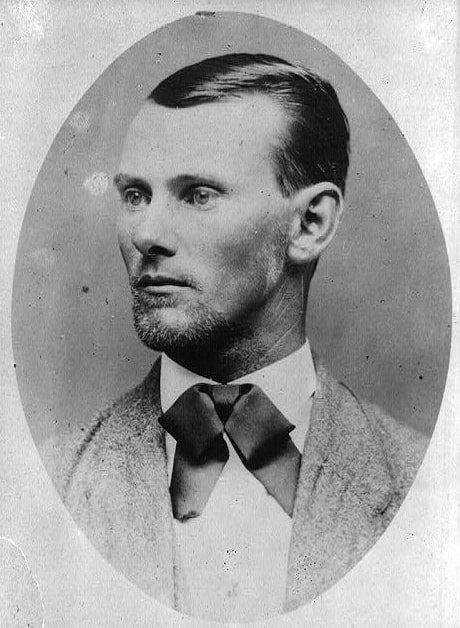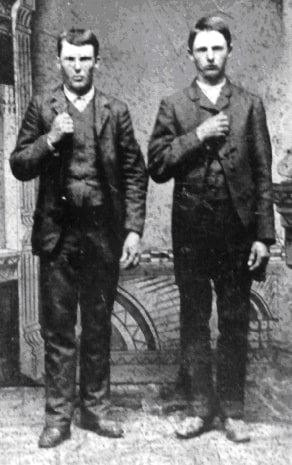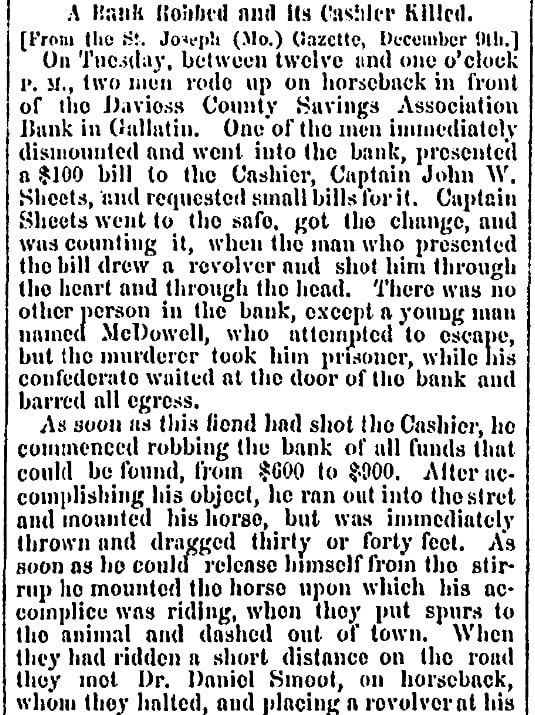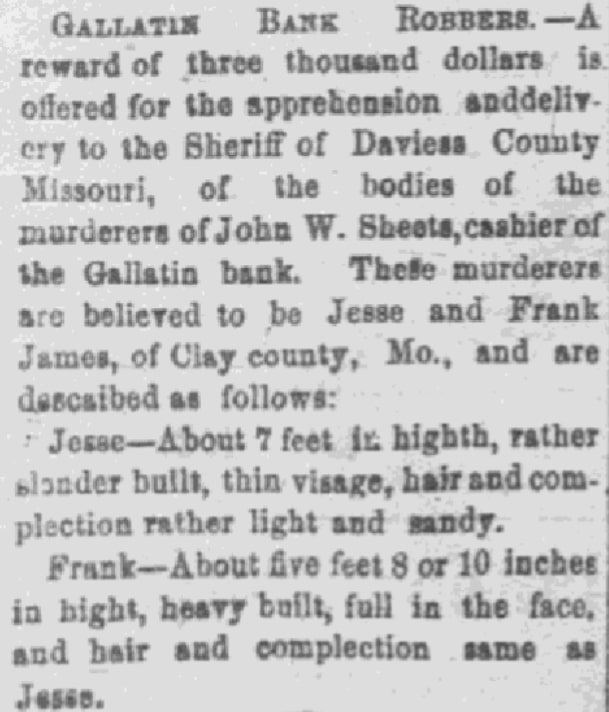Jesse James is one of the most notorious outlaws in American history. He and several other former Confederate guerrillas (his brother Frank, and the four Younger brothers – Bob, Cole, Jim and John) kept up their violent ways long after the Civil War ended. The James-Younger Gang had a remarkably successful career until the disastrous Minnesota bank robbery in 1876 that broke up the gang. Although they were all tough men, strong riders and fierce fighters, it was Jesse James who became the most famous.

This in part was due to a friendship Jesse had with John Newman Edwards, an editor and former Confederate cavalryman, who founded the Kansas City Times. Edwards wrote many articles praising Jesse (and by extension his fellow gang members), creating a heroic myth that Jesse James was a loyal Confederate soldier who refused to surrender, continuing to defend his hard-working Missouri compatriots after the Civil War from marauding carpet-baggers and Northern humiliations. Jesse gleefully joined in creating this myth, writing many letters to the editor that Edwards dutifully published.
Although he may well have participated in an 1868 robbery, it was the brutal robbery of the Daviess County Savings Association Bank in Gallatin, Missouri, on 7 December 1869, that first got Jesse’s name in print. He and an associate (probably Frank) boldly robbed the bank in the middle of the day.

The bank’s cashier was Captain John W. Sheets, a long-established resident and well-respected member of the community with a wife and several children. Jesse erroneously thought Sheets was Samuel P. Cox, a former Union militia officer who had killed one of the most ruthless Confederate guerrilla leaders, “Bloody Bill” Anderson. Jesse, convinced he was avenging one of his wartime heroes, blasted two bullets into the innocent Sheets, one in his heart and one through his head.
The murder enraged the town, but Jesse and Frank managed to slip right through the pursuing posse’s clutches, as they would time and time again in their criminal career. The ensuing uproar got the attention of Missouri Governor Thomas T. Crittenden, who placed a bounty on the James brothers – getting Jesse’s name in print for the first, but certainly not the last, time.
The Gallatin murder/robbery therefore established three of the main components in Jesse James’s outlaw career: 1) his mistaken revenge for “Bloody Bill” Anderson emphasized his role as loyal Confederate; 2) his escape from the posse exhibited his daring; and 3) the exploit got his name in the papers, and the press found in him a figure that captured their readers’ interest.
The following two newspaper articles are about the 1869 Gallatin robbery, the first confirmed robbery in Jesse James’s career. The first article reports on the robbery itself, providing many interesting details. The second article puts Jesse James’s name in print.
This first article about the Gallatin robbery was published by the Gazette in St. Joseph, Missouri, and reprinted by the Sacramento Daily Union.

Here is a transcription of this article:
A Bank Robbed and Its Cashier Killed.
[From the St. Joseph (Mo.) Gazette, December 9th.]
On Tuesday, between twelve and one o’clock P.M., two men rode up on horseback in front of the Daviess County Savings Association Bank in Gallatin. One of the men immediately dismounted and went into the bank, presented a $100 bill to the cashier, Capt. John W. Sheets, and requested small bills for it. Capt. Sheets went to the safe, got the change, and was counting it, when the man who presented the bill drew a revolver and shot him through the heart and through the head. There was no other person in the bank, except a young man named McDowell, who attempted to escape, but the murderer took him prisoner, while his confederate waited at the door of the bank and barred all egress.
As soon as this fiend had shot the cashier, he commenced robbing the bank of all funds that could be found, from $600 to $900. After accomplishing his object, he ran out into the street and mounted his horse, but was immediately thrown and dragged thirty or forty feet. As soon as he could release himself from the stirrup he mounted the horse upon which his accomplice was riding, when they put spurs to the animal and dashed out of town. When they had ridden a short distance on the road they met Dr. Daniel Smoot, on horseback, whom they halted, and placing a revolver at his head, ordered him to dismount. Seeing that they were desperadoes, armed to the teeth, he concluded that his only safety was in complying with their demand.
Immediately one of the robbers jumped upon the horse which they had thus summarily captured, and the two rode in the direction of the Hannibal and St. Joseph Railroad with all speed.
[From the same paper, December 10th.]
Not more than ten minutes had elapsed before a party of citizens were in pursuit. The pursuing party, for some distance, occasionally came in sight of the fugitives, but could not overtake them. The latter struck off southwesterly in the direction of Kidder. A couple of miles north of that place they met Rev. Mr. Helm, a Methodist clergyman, returning from town, and stopping him, compelled him to guide them round the place. They crossed the railroad half a mile west of Kidder, and when last heard from were ten miles south of that place, going in the direction of the Missouri river. Parties are out in various directions, and no efforts will be spared to secure the scoundrels.
Between Gallatin and Kidder the murderers stopped and conversed with several persons. They said they had killed Major S. P. Cox, if they had not made a mistake in the man – one of the men stating that he was Bill Anderson’s brother, and that Major Cox had killed Anderson. The general impression, however, is that the sole object of the men was to obtain the money in the bank.
There was in the bank at the time only $700. In their hurry the robbers, instead of taking the package containing this, took a package containing about $5 in fractional currency. McDowell, a lawyer, who had his office in the bank, had a narrow escape. He was shot at twice as he ran out of the door to give the alarm.
Captain John W. Sheets was one of the oldest residents of Daviess county, and a man of considerable property. Honorable, quiet and unassuming, an estimable citizen in all the relations of life, and a firm friend, he was one of those men who always secure the respect and regard of the entire community.
Captain Sheets was shot twice – one ball entering the forehead and passing directly through the head; the other going directly through the heart.
The murderers crossed the railroad near the residence of Patrick S. Kenny, Esq. Word had been sent to Mr. K., and immediately on its receipt he armed himself with a double-barreled shotgun and took up his post near the crossing. Here he remained on watch some three hours, when, from a gentleman who came along, he learned that the scoundrels had crossed the road at that place about fifteen minutes before word of the affair reached his house.
This second article about the Gallatin bank robbery identifies Jesse and Frank James as the thieves.

Here is a transcription of this article:
GALLATIN BANK ROBBERS.
A reward of three thousand dollars is offered for the apprehension and delivery to the sheriff of Daviess County, Missouri, of the bodies of the murderers of John W. Sheets, cashier of the Gallatin bank. These murderers are believed to be Jesse and Frank James, of Clay County, Mo., and are described as follows:
Jesse: About 7 [correction: 6] feet in height, rather slender built, thin visage, hair and complexion rather light and sandy.
Frank: About 5 feet 8 or 10 inches in height, heavy built, full in the face, and hair and complexion same as Jesse.
Note: An online collection of newspapers, such as GenealogyBank’s Historical Newspaper Archives, is not only a great way to learn about the lives of your ancestors – the old newspaper articles also help you understand American history and the times your ancestors lived in, and the news they talked about and read in their local papers.
Related Articles:
